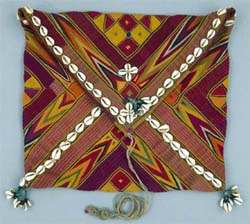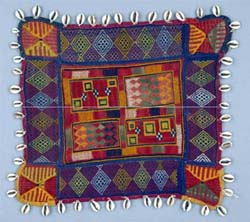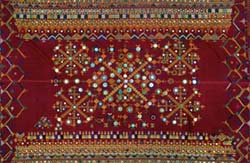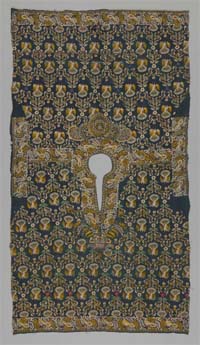Jan 02, 2026
Jan 02, 2026
by V. Radhika
 A rich collection of 101 embroidered artefacts, crafted by rural women and urban professional embroiderers in Pakistan and India between the 18th and 20th century, form an ongoing exhibition at the Textile Museum of Canada in Toronto. Titled 'Color and Light: Embroidery from India and Pakistan', the exhibition takes visitors on a colorful journey into the world of fiber, where threads deftly present a tapestry of the socio-economic, cultural and political milieu of their times.
A rich collection of 101 embroidered artefacts, crafted by rural women and urban professional embroiderers in Pakistan and India between the 18th and 20th century, form an ongoing exhibition at the Textile Museum of Canada in Toronto. Titled 'Color and Light: Embroidery from India and Pakistan', the exhibition takes visitors on a colorful journey into the world of fiber, where threads deftly present a tapestry of the socio-economic, cultural and political milieu of their times.
The exhibits have been drawn from the museum's holdings of South Asian textiles. Each piece evokes the imagery of South Asian life, where embellished garments and accessories - crafted by embroiderers in workshops or at home by nimble-fingered women - are a part of life, celebration, ritual and, of course, royalty.
Spread out on the third floor of the museum, the exhibition is categorized into various sections: 'Diverse Expressions'; 'Court and Commerce'; 'Pasture, Farm and Village'; 'Ceremonies and Celebrations'; 'Embroidery and Identity'; 'Embellishing the Home'; 'World of Humans/Realm of Gods'; and 'Embroidering the Future'.
Each section treats its audience to a unique aspect of life in the region. The sections thus reflect the spatial spectrum embroidery occupied and also the important role it played. Right from nomadic and sedentary communities for whom embroidery is an essential part of daily life, to the role of embroidery in rites of passage and also the importance of embroidery and clothing as a means of asserting communal affiliation. Some of these embroideries now remain only in museums as their production has ceased altogether.
"I wanted to show the diversity of South Asian embroidery and how it has touched every aspect of life," explains Los-Angeles based Dale Gluckman, who was specially invited to curate the exhibition.
Take the case of 'Diverse Expressions'. This part of the show hints at the harsh terrain of their region of origin through the use of wool, silk and pashmina (made from wool from the underbelly of the Himalayan goat) as base fabric and thread, thus indicating the cold, hilly and challenging lifestyle of their creators. One can consequently imagine life in the mountains of Kashmir in India and the Northwest Frontier Province in Pakistan.
 'Ceremonies and Celebration' (which easily entwine families and friends in both India and Pakistan) presents a bridal headdress, amongst other auspicious and interesting exhibits.
'Ceremonies and Celebration' (which easily entwine families and friends in both India and Pakistan) presents a bridal headdress, amongst other auspicious and interesting exhibits.
Strolling past 'Pasture, Farm and Village' is rather like traversing the sand dunes of the embroidery belt that stretches from the mountainous Northwest Frontier Province (Pakistan) to the Thar Desert and into northern Gujarat and Rajasthan (India). Mirrors and cowrie shells unified with threads of vibrant hues charge the wall hangings, belts, decorative cattle gear and other accessories with life. These threads seem to victoriously add a dash of color to their plain desert landscape. In contrast to the professional male artisans of the royal courts, it is the women of semi-nomadic pastoralist tribes, who created such work within the confines of their humble homes.
Embroidery also indicates a community's religious orientation, as has been projected through 'Embroidery and Identity'. This segment reveals that the garments worn by Muslims can be identified by the geometric patterns of unrivalled precision and complexity. On the other hand, Hindu tradition surfaces through the stylized animal motifs.
 However, visitors can also see an instance of synthesis between embroideries of some Hindu and Muslim communities. A mirror-work embroidered blouse on display is one such example. Although the style and fabric suggest origins from a Muslim community, it was actually patterned by a Hindu Meghwal woman (belonging to the Meghwal tribe) living close to Banni district in Gujarat and was influenced by the community's embroidery.
However, visitors can also see an instance of synthesis between embroideries of some Hindu and Muslim communities. A mirror-work embroidered blouse on display is one such example. Although the style and fabric suggest origins from a Muslim community, it was actually patterned by a Hindu Meghwal woman (belonging to the Meghwal tribe) living close to Banni district in Gujarat and was influenced by the community's embroidery.
Similarly, a ceremonial cover from Himachal Pradesh is an ornate expression with floral borders surrounding the Mughal miniature paintings. This work was possibly a combined endeavour of painters and embroiderers with court painters (who trained at Mughal courts) drawing the design and professional embroiders threading it to life. In some others, the complex geometric patterns of Islamic traditions rub shoulders with imaginative motifs of Hindu artistic expression.
There are other linkages such as the Soof embroidery used by several interrelated communities of Sind in Pakistan and Kutch in India. Interestingly, the Soof (which means 'neat and clean') stitch is worked from the back of the fabric by counting the weave of the fabric and inserting the needle at regular and designated intervals. Then there is the wall hanging that showcases a hybrid style of 'mochi' (a minute chain stitch done by a hook) and 'kathiawari' (from the Kathiawar region in Gujarat, done on satin and khadi fabric) embroidery, where the close herringbone stitch has replaced the traditional 'mochi' chain filling.
 Some of the craft on display has traversed greater boundaries, threading together the taste and skill of different regions. Until 1950, professional Chinese embroiderers in the port of Surat in Gujarat produced tunics for girls of urban Parsi families. In fact, many Parsi women wore saris with 'chinai' or the Chinese style of embroidery. For a long time, embroidered floor spreads exported in large numbers to Europe from Portuguese-controlled Goa were erroneously thought to be made in Portugal or influenced by Portuguese embroidery. However, they were actually produced in India and owed their colors and interpretation of floral motifs to the embroidery of 17th century England.
Some of the craft on display has traversed greater boundaries, threading together the taste and skill of different regions. Until 1950, professional Chinese embroiderers in the port of Surat in Gujarat produced tunics for girls of urban Parsi families. In fact, many Parsi women wore saris with 'chinai' or the Chinese style of embroidery. For a long time, embroidered floor spreads exported in large numbers to Europe from Portuguese-controlled Goa were erroneously thought to be made in Portugal or influenced by Portuguese embroidery. However, they were actually produced in India and owed their colors and interpretation of floral motifs to the embroidery of 17th century England.
Amongst the several not-to-miss pieces is the oldest from the collection: a shawl from Bangladesh embroidered between 1820-1830.
If elegance characterizes the work of professional embroiderers, intricate designs are the hallmark of women's work. Elaborates Gluckman, "What fascinates me is the incredible design and color sense seen in many of the pieces despite the fact that the embroiderer never had any art education in the formal sense. The second thing that interested me about the embroideries is their amazing diversity and their importance to every aspect of Indian life - from clothing to ritual."
Patricia Bentley, the education curator at the museum, states that the Indian subcontinent has been a leader in some textile productions, embroidery being one of them. While it is true that some of these things are not made any more, she says that, "embroidery is still a living craft in India and the story of how it's being revitalized is an interesting one".
Apart from public tours, dance and music programmes, artisans from various regions are giving live demonstrations of embroidery at the museum. There is also a video installation featuring prominent south Asians. Interestingly, the museum got students involved in the theme of 'Out of Grandmother's Closet', encouraging them to explore their heritage by peering into their grandmother's closet - in other words, the textiles at home.
07-Jul-2007
More by : V. Radhika